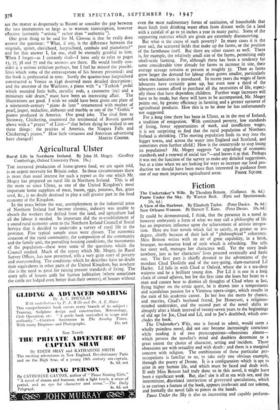Agricultural Ulster
Rural Life in Northern Ireland. By John M. Mogey. (Geoffrey Cumberlege, Oxford University Press. 15s.) THE increased production of home-grown food, we are again told, is an urgent necessity for Britain today. In these circumstances there is more than usual interest for such a report as the one which Mr. Mogey has prepared on rural life in Northern Ireland. This is all the more so since Ulster, as one of the United Kingdom's most important home suppliers of meat, bacon, eggs, potatoes, flax, grass seed, &c., is no doubt destined to play a still greater part in the food economy of the Kingdom.
In the years before the war, unemployment in the industrial areas of Northern Ireland had become chronic, industry was unable to absorb the workers that drifted from the land, and agriculture had all the labour it needed. So important did the re-establishment of a sound rural economy seem to the Northern Ireland Council of Social Service that it decided to undertake a survey of rural life in the province. Five typical sample areas were chosen. The economic situation of the rural community, the composition of the community and the family unit, the prevailing housing conditions, the movements of the population—these were some of the questions which the Council studied. Much of the report which Mr. Mogey, its Rural Survey Officer, has now presented, tells a very grim story of poverty and overcrowding. The conditions which he describes have no doubt their equivalents in other parts of the United Kingdom, but nowhere else is the need as great for raising present standards of living. The story tells of houses unfit for human habitation (where sometimes the cattle are lodged even better than their owners), of houses without even the most rudimentary forms of sanitation, of households that must fetch their drinking water often from distant wells (in a land with a rainfall of 40 to 50 inches a year in many parts). Some of the supporting statistics which are given are extremely disconcerting.
But what is the cause of such poverty? In many cases it is the poor soil, the scattered fields that make up the farms, or the position of the farmhouse itself. But there are other causes as well. There is, for example, the relatively small size of the farms, permitting only small-scale farming. For, although there has been a tendency for some considerable time already for farms to increase in size, their average acreage remains at present at roughly 35. Then as farms grow larger the demand for labour often grows smaller, particularly when mechanisation is introduced. In recent years the wages of farm labourers have certainly gone up, but even now a third of the labourers cannot afford to purchase all the necessities of life, especi- ally those that have dependent children. Further wage increases will have to be made, but these will have to be accompanied, Mr. Mogey points out, by greater efficiency in farming and a greater turnover of agricultural products. How this is to be done he has unfortunately not suggested.
For a long time there has been in Ulster, as in the rest of Ireland, a tradition of emigration. With continued poverty, low standards of living, fewer opportunities of work, and insufficient wages, it is not surprising to find that the rural population of Northern Ireland is shrinking. (The moving population finds its way into the bigger towns, and across the water into England and Scotland, and sometimes even further afield.) How is the countryside to stop losing its population? Mr. Mogey suggests "an upgrading of economic standards and a renewal of social ties "—and leaves it at that. Perhaps it was noi the function of the survey to make any detailed suggestions, but at a time when we are looking for ways to increase our food pro- duction we should have been more than interested in guidance from
one of our most important agricultural areas. FRANIC SQUIRE.


































 Previous page
Previous page